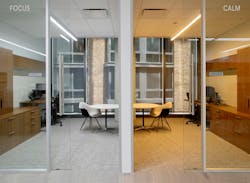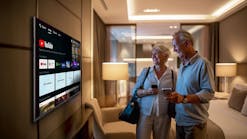The Michael Best Law Firm is Using Lighting to Retain and Recruit the Best Legal Minds
When it made the decision to relocate its Washington D.C. office, Michael Best LLC mapped out a laundry list of both critical and aspirational items it wanted to incorporate into the design of its new space. Being a firm that was growing its intellectual property book of business, it had first-hand knowledge of new and emerging technologies that could make the new space one of the most innovative, comfortable and appealing in the entire city.
LED lighting controlled by color temperature tuning capabilities was at the top of the list. What began as an item on the wish list is now one of the first commercial office environments where SpectraSync™ Color Tuning Technology from Hubbell Control Solutions is being used.
The Location and Design
Michael Best is a full-service global law firm with more than 250 lawyers and 13 different office locations across the United States. The firm serves regional, national and international corporations, as well as municipalities, trade associations, nonprofits, family trusts and individuals. Its clients range in size from small start-up ventures to global Fortune 500 companies in many different industries, and it has a long history of serving clients in the consumer and industrial products sectors. As those sectors evolve, its practice has grown to encompass a diverse range of technology and software clients.
Previously Michael Best had lawyers based at 602 Pennsylvania Avenue and the Strategies division operating at 801 Pennsylvania Avenue. The firm decided to consolidate operations at the new District Wharf development along the southwest waterfront.
Previously the D.C. historic fish market, The Wharf has been developed to become the city’s premiere meeting place, where restaurants, entertainment, events and the waterfront lifestyle beckon natives and visitors.
To attract and retain the best employees, Michael Best decided it would base its new office in 31,000 square feet of Class A office space at 1000 Maine, one of the first commercial office facilities built at The Wharf. Featuring impressive natural light and ten-foot floor-to-ceiling windows, the spaces within this commercial facility offer some of the best views of the city, the Potomac River and the nation’s landmarks.
Designing a Destination, Not Just an Office
In commercial environments, good design has become synonymous with talent hiring and retention. Being a design build, Michael Best realized it had a significant opportunity to incorporate many of the items from the wish list. With a keen understanding of the LED lighting marketplace, the firm decided it would integrate more than just cutting-edge luminaires into the design and added color temperature tuning (“CCT”) lighting technology to the spec list.
After evaluating solid-state lighting (“SSL”) products and control systems from a number of vendors, the general contractor – Harvey-Cleary Builders – and Michael Best selected Hubbell Lighting as the luminaire and controls supplier. Hubbell’s local agent, One Source Associates, was tapped to develop a tunable SSL system that would meet the needs of varying light color and quality to provide employees ideal light while also meeting LEED requirements for energy efficiency.
Even with an open office layout with many large windows and significant daylighting options, there would still be areas where employees don’t receive enough daylight due to factors such as season, cloud cover, desk orientation and window shade position. Research shows that occupants see real value in being able to control the lighting temperature in their spaces. By strategically integrating this technology into its design, the firm understood it would then be able to add to its already impressive list of perks for current and prospective employees.
These areas were targeted to benefit substantially with the SpectraSync solution.
The SpectraSync Experience and the Human Impact
In the private offices, occupants can adjust both intensity and color temperature of the Litecontrol MOD™ 2L Surface Direct fixtures with integrated SpectraSync technology based on need or preference. NX Distributed Intelligence™ CCT Switch Stations are equipped with four presets that can be customized in the field or utilized with default programming from the factory. One advantage of the presets – it provides the occupant with the proper color and intensity of light rather than an average light level or high CCT, without compromise to vertical illuminance.
Michael Best elected to use the following presets:
- “Focus” – 5000K
- “Work” – 4200K
- “Normal” – 3500K
- “Calm” – 2700K
Additionally, the NX Specialty Switch Station provides employees with the ability to raise and lower the brightness of the lighting, as well as turn the lights on and off in a room or designated zone. This can be used in conjunction with the color tuning wall station and operates independently from the color control. This offers employees another level of dimming control they can select based on their mood, the requirements of work to be done in the space and daylighting conditions.
Blythe Peelor, administration & operations manager for Michael Best, can set meeting spaces to cool lighting during business and warm lighting during a special social event. In addition to the Litecontrol MOD fixtures, Prescolite’s LF4 and Kurt Versen’s 5″ Round Xicato are used in common areas, conference rooms and the lobby.
Employees have the ability to adjust the SpectraSync-enabled luminaires in their offices, workspaces and conference rooms with the simple touch of a button. Employees can adjust the lighting to meet their personal preferences, enhance visibility, materials and colors or the aesthetics of the space.
Because the SpectraSync system runs on the NX Distributed Intelligence backbone, there’s opportunity for Michael Best to tweak the system and make updates as needed. Through its work with technology companies, Michael Best is aware that light does have an impact on people. Ongoing research is being facilitated to understand how light can affect human sleep cycles, health and productivity. For example, the integral NX sensors allow Michael Best to automatically adjust brightness levels to account for incoming natural light. Vacancy sensors are already being used to override control of all fixtures, enhancing the project’s efficiency.
Neither industry nor academia have fully converged a prescriptive approach for circadian lighting. A considerable amount of ongoing research is being conducted to identify how different intensities and colors affect people at a neurological level. It has been proven that adjusting office lighting to simulate changes in outdoor sunlight levels, based on the time of day, can enhance worker productivity. Both daylight, courtesy of Earth’s 24-hour light–dark cycle, and electric light can drive the human circadian system, internal clocks that regulate daily behaviors and the timing of biological processes, such as the release of the hormones melatonin and cortisol, which help control blood sugar and affect energy levels.
In August 2019, the University of Oregon published a whitepaper, “The Impact of Lighting and Views in the Workplace of the Future.” (https://cpb-us-e1.wpmucdn.com/blogs.uoregon.edu/dist/3/15526/files/2019/08/20190503_Whitepaper-The-impact-of-lighting-and-views-on-the-workplace-of-the-future.pdf) The paper concludes that daylighted spaces with controlled lighting and views can improve occupant well-being, workplace productivity, and satisfaction by positively influencing various physiological and psychological processes. The researchers concluded, “lighting and views also impact property value and employee recruitment and retention.”
However intangible, the lighting solution that supports this office is seen as an advantage for Michael Best, since happier employees are more productive and more likely to stay in an organization. Anecdotal evidence shows employees are more comfortable based on their personal preferences.
This project demonstrates that light impacts people, and office space that is designed around the users of the space, rather than the space itself, can be a strategic asset. By getting the lighting right, it has become an environment everyone wants to spend time in.
“Adjusting office lighting to simulate changes in outdoor sunlight levels, based on the time of day, can enhance employee productivity. Happier employees are more productive and more likely to stay with us. Bottom line: this technology helps make people more comfortable, based on their personal preferences.” - Blythe Peelor, Administration & Operations Manager, Michael Best
Contact:
Michael McCullough
Hubbell Control Solutions





